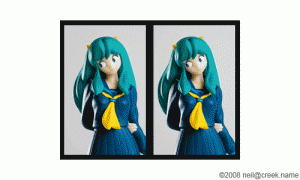3D has come back and you have read some of the posted articles here on 3D and the many ways you can enjoy the viewing treat. But did you know that there is another way for you to experience 3D without using any specially gadgets at all? Saw an article written by a photographer Niel Creek, he specializes in the field.
Why Cross Eyes? According to Niel Creek
When overlapping stereo pairs without special glasses, you can get the 3D effect by crossing your eyes or diverging your eyes. I prefer the crossed eye method. I find it easier to control, and it is possible to view larger 3D images than with the diverging technique.

How is it done? The technique is called Stereo Pairs –
To see a 3D image, each eye needs to see a different view. There are ways to take photos like this, When the two slightly different images are processed, they are placed side-by-side so that the viewer can use a special “crossed-eye” technique to overlap them, and see both views together in 3D.
The example given here , is an animation that simulates what it looks like when you view these images in 3D. The instructions follow.
Niel Creek Tells us how to master the technique step by step:
- Sit square in front of your monitor, with the image directly in front of you, at about arm’s length
- Sitting further back makes it easier – you don’t need to cross your eyes as much – but makes the image look smaller
- Make sure you keep your head level horizontally, tilting your head will prevent you from merging the images
- While keeping the stereo pair of images in the centre of your vision, slowly cross your eyes
- The stereo pair will go out of focus and you will seem to see four images, as shown in the animation above
- If you find it hard to cross your eyes, it can help to hold a pen in front of you and look at the tip with the stereo pair in the background
- Gradually cross your eyes more and more – if using a pen to assist, start it close to the monitor and move it towards your nose
- Continue crossing your eyes more, untill the centre two of the four images overlap and you see three blurry images, as in the animation above
- Try and hold the centre image together – it is possible to “lock” it in place and see it as one image
- The “locked” centre image should appear in 3D!
- Now the tricky part, focus – while holding the 3D image in place, relax your eyes – drop the pen from your field of view if you are using it
- If you can keep the 3D image locked and relax your eyes, it should eventually pop into focus, as in the last frame of the animation above
He gave a warning though that not everyone can do it. Specially the ones that have weak eye control. I myself cannot do it.
Do you want to know how it is done? Check out this article by Niel Creek – 9 Crazy Cross Eye 3D Photography Images and How to Make Them from the Digital Photography School Blog. Can you do it? Let me know!
COMMENTS